SDG15.2.3 Maintain and extend current ecosystems’ biodiversity-2021
NCUE has at least six ongoing projects and activities, including: Environmental Education Centre’s ‘Project of Taoyuan International Airport Corporation/Entrusted Planning and Design for RIFA Control’; ‘Twenty-four, 33, and 120-Hour Courses for Environmental Education Personnel Certification’; Biology Department’s ‘Project of the Division of Science and Technology/Discussion and Solution Strategies on the Ant Infestation Problems in the Qianshan Caused by the Impact of Climate Change on the Ecology of Qianshan and the Changes in the Community’, Science and Technology Division’s projects ‘Reshape the Prevention and Control of Global Invasive Species: Positioning Taiwan as a Hub for the Prevention and Control, Prediction and Education of RIFA in Asia’ and ‘Microbial Control technology of Agricultural Pest Ant’, a project of the Bureau of Animal and Plant Health Inspection and Quarantine, ‘Council of Agriculture/Development of Core Technologies and Establishment of Safety Assessment Model of the Agricultural Spraying Drone Industry Chain–Field Trials for Using Agricultural Drones to Control RIFA through the Management of Drone Pesticide Spraying Delegation System’. They are briefly introduced in the following section.
1. Project of Taoyuan International Airport Corporation: ‘Entrusted Planning and Design for RIFA Control’
Taoyuan International Airport is located in the Dayuan District. In 2004, Taoyuan International Airport determined that the area around Taoyuan Airport, the airport traffic lane, and some parts of the lawn dividing the running chute were invaded by RIFA. The project team has achieved remarkable results after years of prevention and control work. The entire airport area has been lifted from the list of management by the government in May 2018. However, because Taoyuan International Airport is located in the Dayuan District of Taoyuan City, and the current RIFA population distribution and density in the district is still relatively serious, Taoyuan International Airport is still in an area susceptible to RIFA recurrence. The goal of the project team is thus to continue to assist Taoyuan International Airport in the prevention and control of RIFA in the entire airport area, including the manpower planning and execution in the control and investigation field operation, planning for the types of prevention and control agents, method suggestion and execution, RIFA monitoring execution and control rate reporting, assistance in reports required by the competent authorities, and checking related matters on RIFA prevention and control.
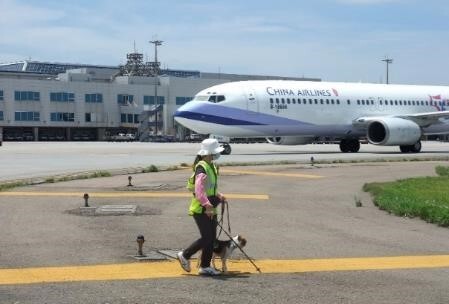 On-duty RIFA detection dog of the Taoyuan International Airport RIFA control team by NCUE |
|---|
Link to the video of the RIFA detection dog participating in the project: https://www.facebook.com/NCUEEEC/videos/a.1053897732014001/286384779600117
2. Twenty-four-, 33-, and 120-Hour Courses for Environmental Education Personnel Certification
The Environmental Education Centre nurtures relevant environmental education talents. In conjunction with the ‘Delve into Fangyuan, Hand in Hand with Dacheng: Industrial and Environmental Sustainability in Twin Cities of Changhua’, the Centre provided relevant education courses for local and national communities from July to October 2020, including Houliao Elementary School special class for environmental education personnel certification in July 2020 (trained 18 environmental education personnel), the 33-hour course for environmental education personnel certification from July to August 2020 (trained 15 environmental education personnel), and the 120-hour training course for environmental education personnel from July to October 2020 (trained 20 environmental education personnel).
 Carrying out environmental ecosystem maintenance design through environmental experiments in Houliao Elementary School special class for environmental education personnel certification |
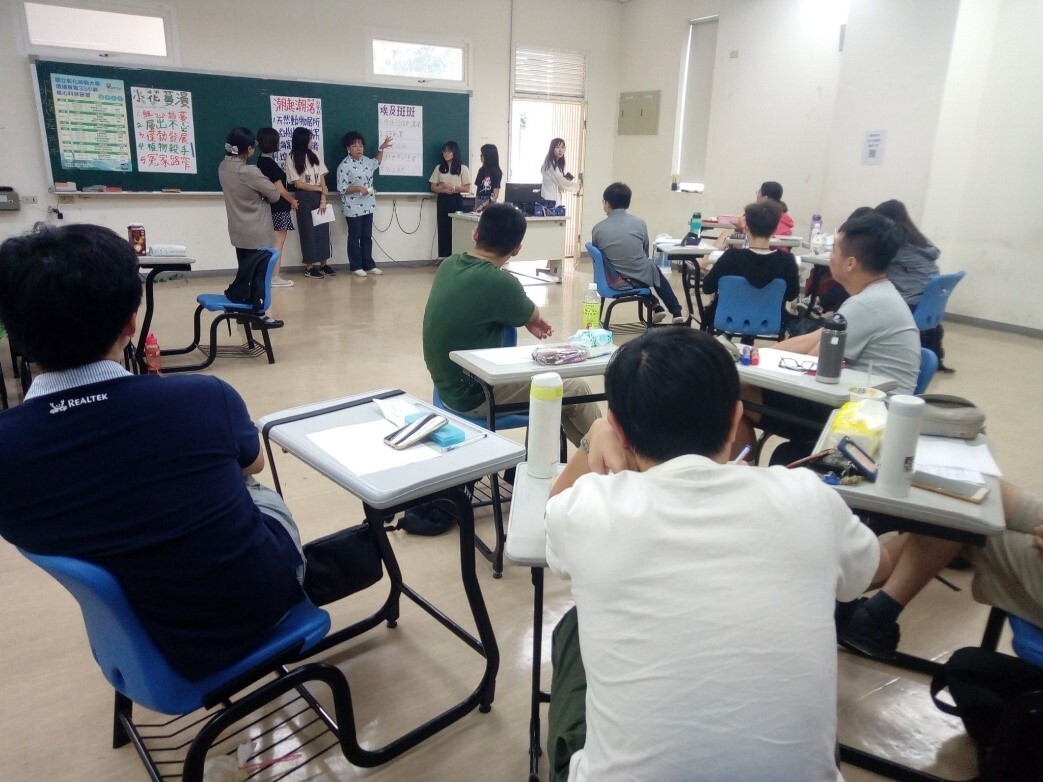 In class of the 33-hour course for environmental education personnel certification |
|---|---|
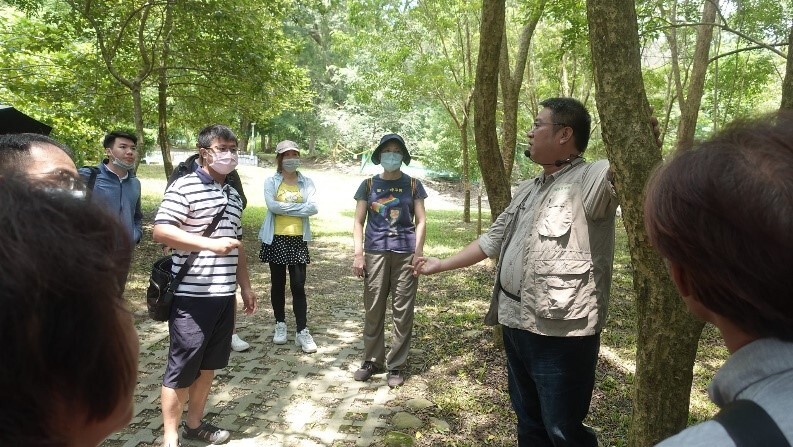 In the macaque pavilion for a class of the 120-hour training course for environmental education personnel certification |
|
Links to the FB pages of the project:
https://www.facebook.com/media/set/?vanity=NCUEEEC&set=a.776743466396097
https://www.facebook.com/media/set/?vanity=NCUEEEC&set=a.792022818201495
https://www.facebook.com/media/set/?vanity=NCUEEEC&set=a.884217642315345
3. Project of the Division of Science and Technology: ‘Discussion and Solution Strategies on the Ant Infestation Problems in the Qianshan Caused by the Impact of Climate Change on the Ecology of Qianshan and the Changes in the Community’
Natural disasters on slopes arising from climate change and man-made development pressure have caused the fragmentation of landscape, ecological fragmentation, and habitat loss, causing slopes in Qianshan, Taiwan, an ecologically fragile area. In addition, recent emerging ant infestation problems have appeared in Qianshan towns in south-central Taiwan. Ants pour into houses like streams, and flying ants invade homes like black mist. Such abnormal ecological responses are warnings of the gradual loss of ecological health in Taiwan. This project integrates multiple domains. It takes the ant infestation problem of the Qianshan residents as the starting point to comprehensively examine the hidden landscape fragmentation, ecological loss, and development pressure behind the ant infestation problem. Using the ecosystem service on the slopes as the research framework, key biofacies in habitat are investigated, landscape changes analysed, indicators established, environmental fragility and ecological potential examined, etc. In addition, in response to the logic of the impact of the ant infestation problem on the industry and tourism in the mountain village communities, a Qianshan agricultural production system with potential for ecosystem services and human well-being are established taking climate change as the background.
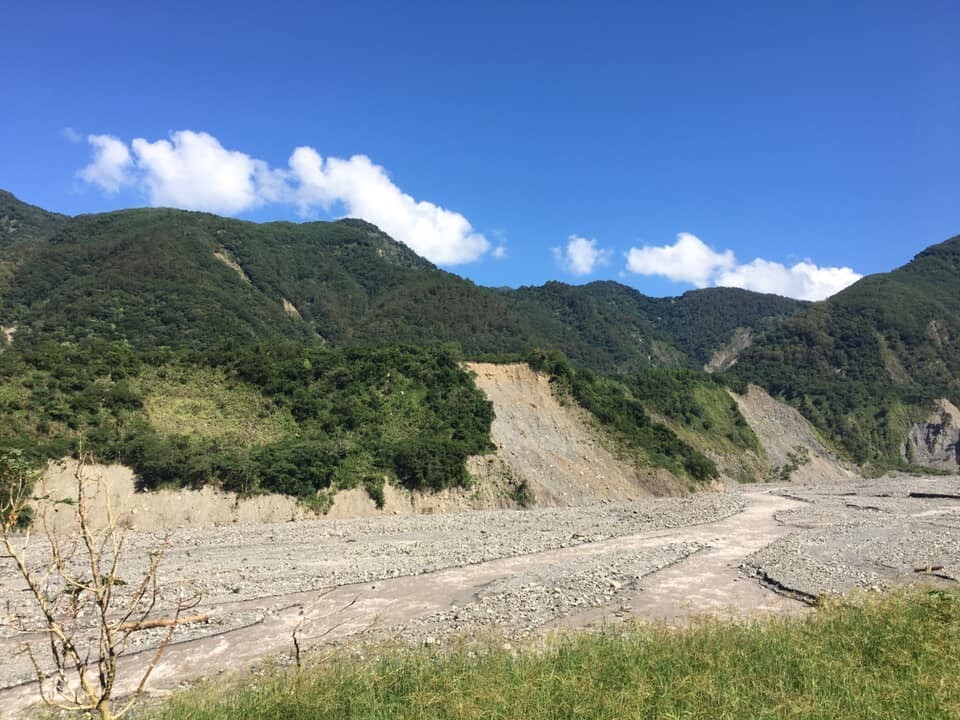 Collapsed area in Qianshan, Liugui District, Kaohsiung City |
|---|
Link for reference information:
https://www.facebook.com/NCUEEEC/photos/a.1053897732014001/1053901572013617
4. Project of the Division of Science and Technology: ‘Reshape the Prevention and Control of Global Invasive Species: Positioning Taiwan as a Hub for the Prevention and Control, Prediction, and Education of RIFA in Asia’
This study uses further data model analysis and establishment of an innovative RIFA invasive platform for the ongoing scientific debate on the causes of the RIFA global invasion, making significant contributions to the prevention of RIFA, its agricultural and economic impacts, and the development of science in Taiwan. This study successfully discovered the pattern of the elimination of RIFA in Taiwan and revealed the proliferation hotspots and paths. In addition, a smart RIFA notification platform was developed, and a harmful ant detection and AI image automatic identification app system was introduced to improve the efficiency and accuracy of the detection of front-line investigators, volunteers, farmers, and the public, so that the sources of infection can be detected early for prevention and control. Through GIS, social network analysis, and foreign and domestic RIFA distribution information, this study has made the following major discoveries: (1) RIFA are mainly distributed across general roads, rice fields, and storage. (2) The way of invasion is through ports with high shipping volume and those having tight connections with high-shipping-volume ports. (3) The main reasons of island-type proliferation in Kinmen were road construction, regional construction, and city development. Therefore, a major part of this research involves assisting the Bureau of Inspection and Quarantine in distributing epidemic prevention resources. This team has been participating in the inter-departmental meetings of the Bureau of Inspection and Quarantine.
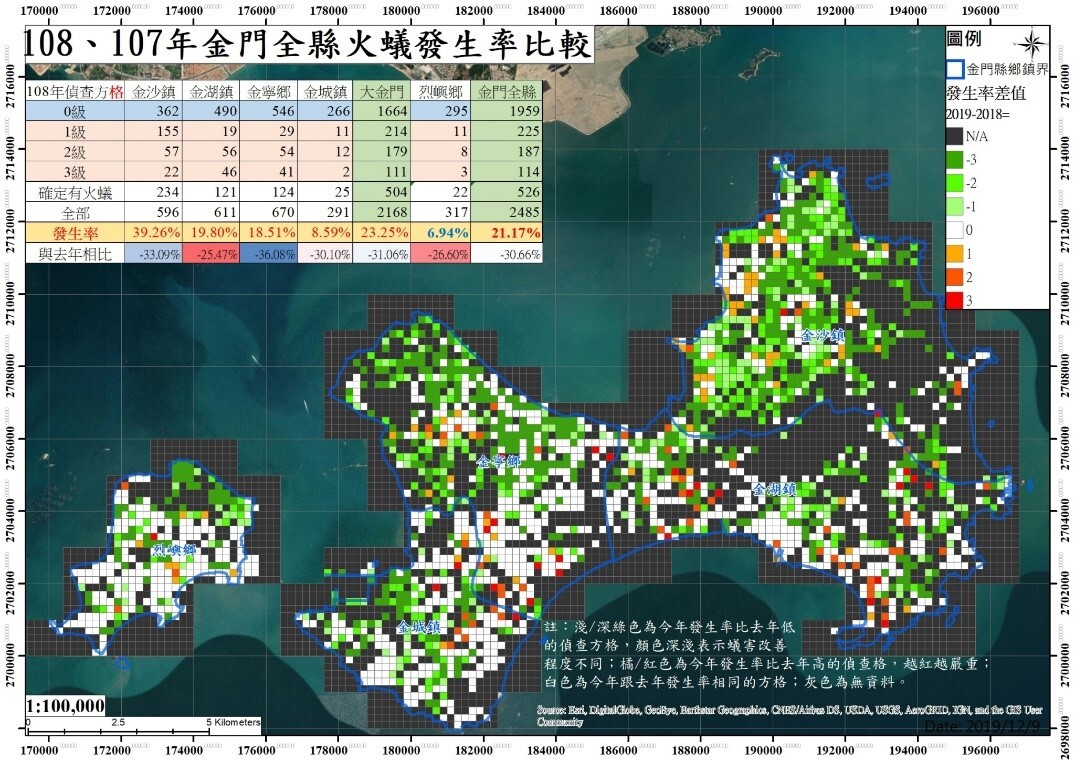 Investigation on the occurrence of RIFA Infestation in Kinmen County |
|---|
Link for reference information:
https://www.facebook.com/media/set/?vanity=NCUEEEC&set=a.1053897732014001
5. Project of the Division of Science and Technology: ‘Development of Microbial Control Technology of Agricultural Pest Ant’
The purpose of this project is the development and application of microbial control for the increasingly serious pest ants in the agricultural environment. Especially considering the development of sustainable agriculture and organic agriculture, this project investigates the design, development, and application of microbial agents for pest ants on crops, and develops its practical value and commercial potential. As biological control is an environmentally acceptable strategy that can reduce the number of pest ants as well as economic losses, entomopathogenic fungi provide an environmentally friendly alternative to chemical pesticides. However, compared with chemical pesticides, the relatively slow action of fungal pathogens hinders their wide use. The project team consists of professional academic research units and vector prevention and control management companies. In addition to the excellent research and development capabilities of academic units, the team has valuable experience in practical applications and commercial development in the industry. On the one hand, the fruitful academic research results can be shared with the industry to promote industrial upgrading; on the other hand, the economic benefits in the market and commercial value of such technology products can be developed so that this technology can truly gain global popularity. The research project has found that the ant pathogen AN_dt1901 (Aspergillus sp. A) has the characteristics of rapidly infecting the nest and killing the major pest ants in the current agricultural environment, Dolichoderus thoracicus. It has the potential to be used in the microbial control of pest ants in agricultural land. These research results have been published in one paper in SCI and have also been used in one submitted SCI paper; they have also been used in two applied for invention patents.
 Forty-eight to 96 hours after Dolichoderus thoracicus is infected by four kinds of fungi. After AN_dt1901 is used on Dolichoderus thoracicus, hyphae and conidia will grow on the body. |
|---|
Link for reference information:
https://www.facebook.com/NCUEEEC/photos/a.1053897732014001/1056518568418584
6. Project of the Bureau of Animal and Plant Health Inspection and Quarantine, Council of Agriculture: ‘Development of Core Technologies and Establishment of Safety Assessment Model of the Agricultural Spraying Drone Industry Chain–Field Trials for Using Agricultural Drones to Control RIFA through the Management of Drone Pesticide Spraying Delegation System’
In areas with a large-scale RIFA invasion, bait spreading is currently still the main prevention and control mode. However, in the RIFA prevention and control area, there are still many locations with special terrains (hills and steep slopes, rivers, valleys, fenced farmland, military control areas, etc.) where personnel and current dune buggies cannot perform control tasks. These areas are easily ignored. In many years, due to the terrain restrictions in many prevention and control areas, the coverage rate of prevention and control agents has only reached approximately 70%–75%. Furthermore, these areas may have not been controlled for many years due to terrain factors, resulting in loopholes in the prevention and control and becoming the source of the recurrence of the epidemic. Therefore, this project is mainly to assist in the establishment of the operation specifications for the use of agricultural drones in RIFA pesticide spraying on large areas or special terrains. In addition, the registration and management system for pesticide spraying delegation for prevention and control, through the interface for unmanned aerial vehicle spraying management data, was established.
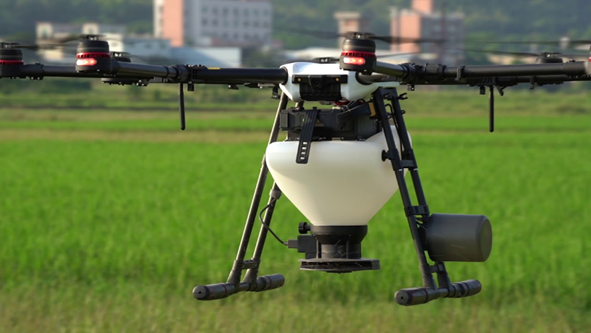 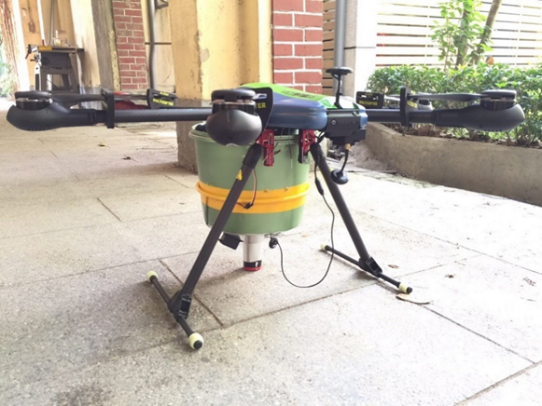 Two unmanned aerial vehicles (UAV) designed according to the specifications and requirements. The MG-1P (left) can carry 10–20 kg of bait, and KK-02 (right) can carry 6–8 kg of bait. |
|---|
Link to the videos of UAV of the project:
https://www.facebook.com/NCUEEEC/videos/a.1053897732014001/2572706636208601

